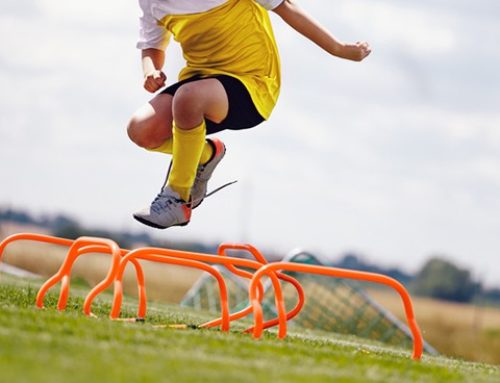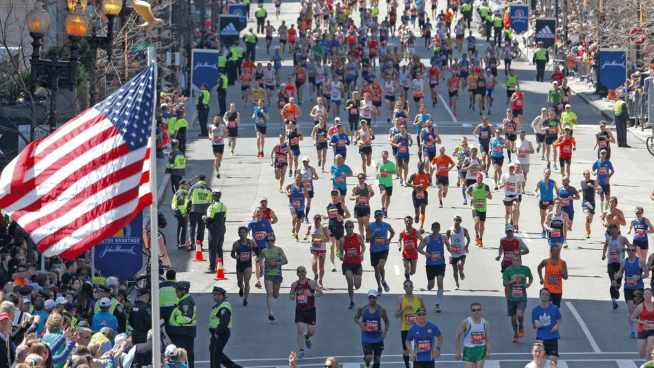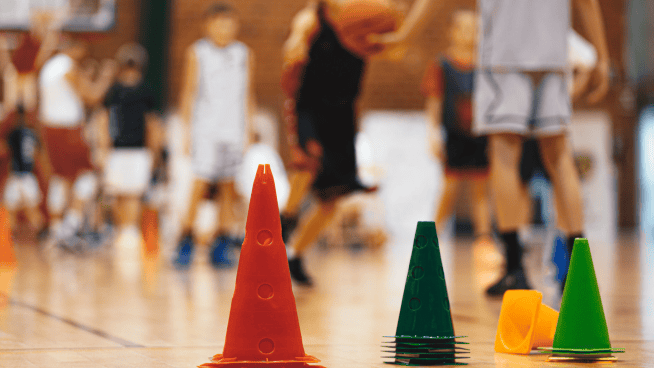Quickness with Virginia Tech Football
Want to be the guy who makes people say, “Man, that dude’s got some serious quicks”? Read on to learn how Virginia Tech’s football team routinely gets fans shaking their heads in disbelief.
Dr. Mike Gentry, Virginia Tech’s director of strength and conditioning and assistant athletic director for athletic performance, literally wrote the book on building highlight-reel-worthy football players. Author of A Chance to Win: A Complete Guide to Physical Training for Football (Sports Publishing), Gentry has molded the Virginia Tech Hokies into some of the most athletic players in college football.
“Football is an open-skill sport with movements of an ever-changing nature,” explains Gentry. “The way a player reacts to different situations dictates how he moves.” Consequently, a player’s success is largely determined by how quickly he responds and adjusts to the changing environment as plays develop.
According to Gentry, football quickness and agility consist of “applying speed, accelerating, decelerating, changing direction, maintaining balance and maximizing power while the environment continues to change.” And although Gentry makes teaching these skills a priority, he thinks three other critical components must be developed first.
“Quickness and agility are the ultimate goal of every strength and conditioning program,” he says, “but strength, power and speed must be targeted in the proper order to build the foundation for quickness training.”
V-Tech quarterback Marcus Vick went from quick to downright sick, dropping his 20-yard shuttle time from an impressive 4.14 to a jock-shaking 3.91. Vick’s improvements, according to Gentry, were a direct result of the Hokies’ quickness program, built on his foundation of strength, power and plyometric training. The payoff? Dazzling on-field moves and national title hopes for the Vick-led V-Tech squad.
Here’s a look at the freak-tested drills Gentry employs to keep his Hokies quicker than lightning.
1. FOOT QUICKNESS
The Hokies perform foot quickness drills before every lifting session. These drills, which are classified as first level plyometric training, improve foot speed and quickness as well as balance and explosive push-off ability of the ankle joints.
Dot Drills
Arrange five three-inch dots in an X pattern two feet wide and three feet long. Perform each drill through the full range of motion (hitting each dot) as quickly as possible in succession for 10-15 seconds; rest and repeat for 3-4 sets. Use a 3:1 rest to work ratio.
1) Apart, Together, Apart*
• Begin facing forward with left foot on bottom left dot and right foot on bottom right dot
• Hop with both feet to middle dot
• Hop to top two dots with feet apart
• Hop backwards through same pattern and repeat
* Can also be performed by spinning at top location and hopping back in forward-facing position
2) Figure 8’s
• Begin with feet together on bottom right dot
• Hop to middle dot
• Hop to top right dot
• Hop to top left dot
• Hop backwards to middle dot
• Hop backwards to bottom left dot
• Finish at bottom right dot
3) Single-Leg Figure 8’s
Same as above, but perform on one leg. Repeat on opposite leg.
4) Zigzag*
• Begin with both feet on bottom right dot
• Hop to bottom left dot
• Hop to middle dot
• Hop to top right dot
• Hop to top left dot
• Reverse order by jumping backward through same Z pattern
* Can also be performed starting at bottom left dot
5) Single-Leg Zigzag
Same as above, but perform on one leg. Repeat on opposite leg.
Jump Rope Drills
Before lifting, warm up with these drills. Perform each for 10-20 seconds with a brief recovery between drills.
• Select a rope that reaches both armpits when standing on it with both feet
• Select drill from list below
• Perform drill keeping weight balanced on balls of feet and knees slightly flexed
• Barely clear floor with each jump
|
STATIONARY
|
WITH MOVEMENT
|
|
Two legs
|
Running forward
|
|
Single leg (right/left)
|
Double-leg hop forward
|
|
Alternate foot
|
Single-leg forward (right/left)
|
|
2 on right |
Double-leg to |
|
Side-to-side
|
High knees
|
2. ACCELERATION
To teach his athletes the proper mechanics of starting and accelerating, Gentry trains them to use a low, driving posture and full range of motion with their arms and legs. He designed drills that force the Hokies to respond to a stimulus, then overcome horizontal inertia to reach full speed as quickly as possible.
V-Tech performs 4-5 reps of these drills 2-3 times per week in the off-season with a 3:1 rest to work ratio.
Ball Drops
• Stand in ready position five yards from partner holding a tennis ball in each hand at shoulder level
• When partner drops a ball, react and sprint to catch it before it bounces twice
Variations:
1) Stand at right angle to partner so you are forced to accelerate laterally
2) Stand facing away from partner; he says “go” when he drops the ball
3) Use a Crazy Ball so bounces are unpredictable, which forces a quicker reaction
Get-Up Sprint Variations
A. Flat on Stomach
• Lie on stomach with chest on line and toes tucked underneath
• When coach calls “go,” push up and bring one foot under you
• Explode out with good forward body lean
B. Flat on Stomach Facing Away
• Lie on stomach with feet on line and head in opposite direction of sprint
• When coach calls “go,” simultaneously push up and turn
• Explode out with good body lean
C. Clap and Sprint
• Lie on stomach with chest on line and toes tucked underneath
• When coach calls “go,” push up and clap
• Explode out with good body lean
3. CHANGE OF DIRECTION
“Because football requires multidirectional movements, improving a player’s quickness in every direction will undoubtedly make him better at his position,” says Gentry.
The Hokies’ change of direction drills fall into two categories: programmable and reactive. Programmable drills run an athlete through a predetermined pattern. Reactive drills force an athlete to react on the fly to a coach’s visual or auditory clue. Many drills can be performed either way. Virginia Tech performs 4-5 reps of these drills 2-3 times per week in the off-season at a 3:1 rest to work ratio.
Hurdle Hop To Sprint/Slide*
• Hop over three knee-high hurdles (see diagram)
• Upon landing, sprint/slide to first cone
• Sprint/slide back to middle cone
• Repeat to each cone returning to the middle cone each time
Star Drill*
• Begin at starting cone, sprint/backpedal/slide to middle cone
• Sprint to first cone and breakdown
• Jog back to middle cone
• Continue sprinting to each cone and jogging back to middle cone
* These can be performed as reactive drills by numbering the cones and having the coach call one out so you have to react to move.
RECOMMENDED FOR YOU
MOST POPULAR
Quickness with Virginia Tech Football
Want to be the guy who makes people say, “Man, that dude’s got some serious quicks”? Read on to learn how Virginia Tech’s football team routinely gets fans shaking their heads in disbelief.
Dr. Mike Gentry, Virginia Tech’s director of strength and conditioning and assistant athletic director for athletic performance, literally wrote the book on building highlight-reel-worthy football players. Author of A Chance to Win: A Complete Guide to Physical Training for Football (Sports Publishing), Gentry has molded the Virginia Tech Hokies into some of the most athletic players in college football.
“Football is an open-skill sport with movements of an ever-changing nature,” explains Gentry. “The way a player reacts to different situations dictates how he moves.” Consequently, a player’s success is largely determined by how quickly he responds and adjusts to the changing environment as plays develop.
According to Gentry, football quickness and agility consist of “applying speed, accelerating, decelerating, changing direction, maintaining balance and maximizing power while the environment continues to change.” And although Gentry makes teaching these skills a priority, he thinks three other critical components must be developed first.
“Quickness and agility are the ultimate goal of every strength and conditioning program,” he says, “but strength, power and speed must be targeted in the proper order to build the foundation for quickness training.”
V-Tech quarterback Marcus Vick went from quick to downright sick, dropping his 20-yard shuttle time from an impressive 4.14 to a jock-shaking 3.91. Vick’s improvements, according to Gentry, were a direct result of the Hokies’ quickness program, built on his foundation of strength, power and plyometric training. The payoff? Dazzling on-field moves and national title hopes for the Vick-led V-Tech squad.
Here’s a look at the freak-tested drills Gentry employs to keep his Hokies quicker than lightning.
1. FOOT QUICKNESS
The Hokies perform foot quickness drills before every lifting session. These drills, which are classified as first level plyometric training, improve foot speed and quickness as well as balance and explosive push-off ability of the ankle joints.
Dot Drills
Arrange five three-inch dots in an X pattern two feet wide and three feet long. Perform each drill through the full range of motion (hitting each dot) as quickly as possible in succession for 10-15 seconds; rest and repeat for 3-4 sets. Use a 3:1 rest to work ratio.
1) Apart, Together, Apart*
• Begin facing forward with left foot on bottom left dot and right foot on bottom right dot
• Hop with both feet to middle dot
• Hop to top two dots with feet apart
• Hop backwards through same pattern and repeat
* Can also be performed by spinning at top location and hopping back in forward-facing position
2) Figure 8’s
• Begin with feet together on bottom right dot
• Hop to middle dot
• Hop to top right dot
• Hop to top left dot
• Hop backwards to middle dot
• Hop backwards to bottom left dot
• Finish at bottom right dot
3) Single-Leg Figure 8’s
Same as above, but perform on one leg. Repeat on opposite leg.
4) Zigzag*
• Begin with both feet on bottom right dot
• Hop to bottom left dot
• Hop to middle dot
• Hop to top right dot
• Hop to top left dot
• Reverse order by jumping backward through same Z pattern
* Can also be performed starting at bottom left dot
5) Single-Leg Zigzag
Same as above, but perform on one leg. Repeat on opposite leg.
Jump Rope Drills
Before lifting, warm up with these drills. Perform each for 10-20 seconds with a brief recovery between drills.
• Select a rope that reaches both armpits when standing on it with both feet
• Select drill from list below
• Perform drill keeping weight balanced on balls of feet and knees slightly flexed
• Barely clear floor with each jump
|
STATIONARY
|
WITH MOVEMENT
|
|
Two legs
|
Running forward
|
|
Single leg (right/left)
|
Double-leg hop forward
|
|
Alternate foot
|
Single-leg forward (right/left)
|
|
2 on right |
Double-leg to |
|
Side-to-side
|
High knees
|
2. ACCELERATION
To teach his athletes the proper mechanics of starting and accelerating, Gentry trains them to use a low, driving posture and full range of motion with their arms and legs. He designed drills that force the Hokies to respond to a stimulus, then overcome horizontal inertia to reach full speed as quickly as possible.
V-Tech performs 4-5 reps of these drills 2-3 times per week in the off-season with a 3:1 rest to work ratio.
Ball Drops
• Stand in ready position five yards from partner holding a tennis ball in each hand at shoulder level
• When partner drops a ball, react and sprint to catch it before it bounces twice
Variations:
1) Stand at right angle to partner so you are forced to accelerate laterally
2) Stand facing away from partner; he says “go” when he drops the ball
3) Use a Crazy Ball so bounces are unpredictable, which forces a quicker reaction
Get-Up Sprint Variations
A. Flat on Stomach
• Lie on stomach with chest on line and toes tucked underneath
• When coach calls “go,” push up and bring one foot under you
• Explode out with good forward body lean
B. Flat on Stomach Facing Away
• Lie on stomach with feet on line and head in opposite direction of sprint
• When coach calls “go,” simultaneously push up and turn
• Explode out with good body lean
C. Clap and Sprint
• Lie on stomach with chest on line and toes tucked underneath
• When coach calls “go,” push up and clap
• Explode out with good body lean
3. CHANGE OF DIRECTION
“Because football requires multidirectional movements, improving a player’s quickness in every direction will undoubtedly make him better at his position,” says Gentry.
The Hokies’ change of direction drills fall into two categories: programmable and reactive. Programmable drills run an athlete through a predetermined pattern. Reactive drills force an athlete to react on the fly to a coach’s visual or auditory clue. Many drills can be performed either way. Virginia Tech performs 4-5 reps of these drills 2-3 times per week in the off-season at a 3:1 rest to work ratio.
Hurdle Hop To Sprint/Slide*
• Hop over three knee-high hurdles (see diagram)
• Upon landing, sprint/slide to first cone
• Sprint/slide back to middle cone
• Repeat to each cone returning to the middle cone each time
Star Drill*
• Begin at starting cone, sprint/backpedal/slide to middle cone
• Sprint to first cone and breakdown
• Jog back to middle cone
• Continue sprinting to each cone and jogging back to middle cone
* These can be performed as reactive drills by numbering the cones and having the coach call one out so you have to react to move.











